Marimo Moss: A Complete Guide
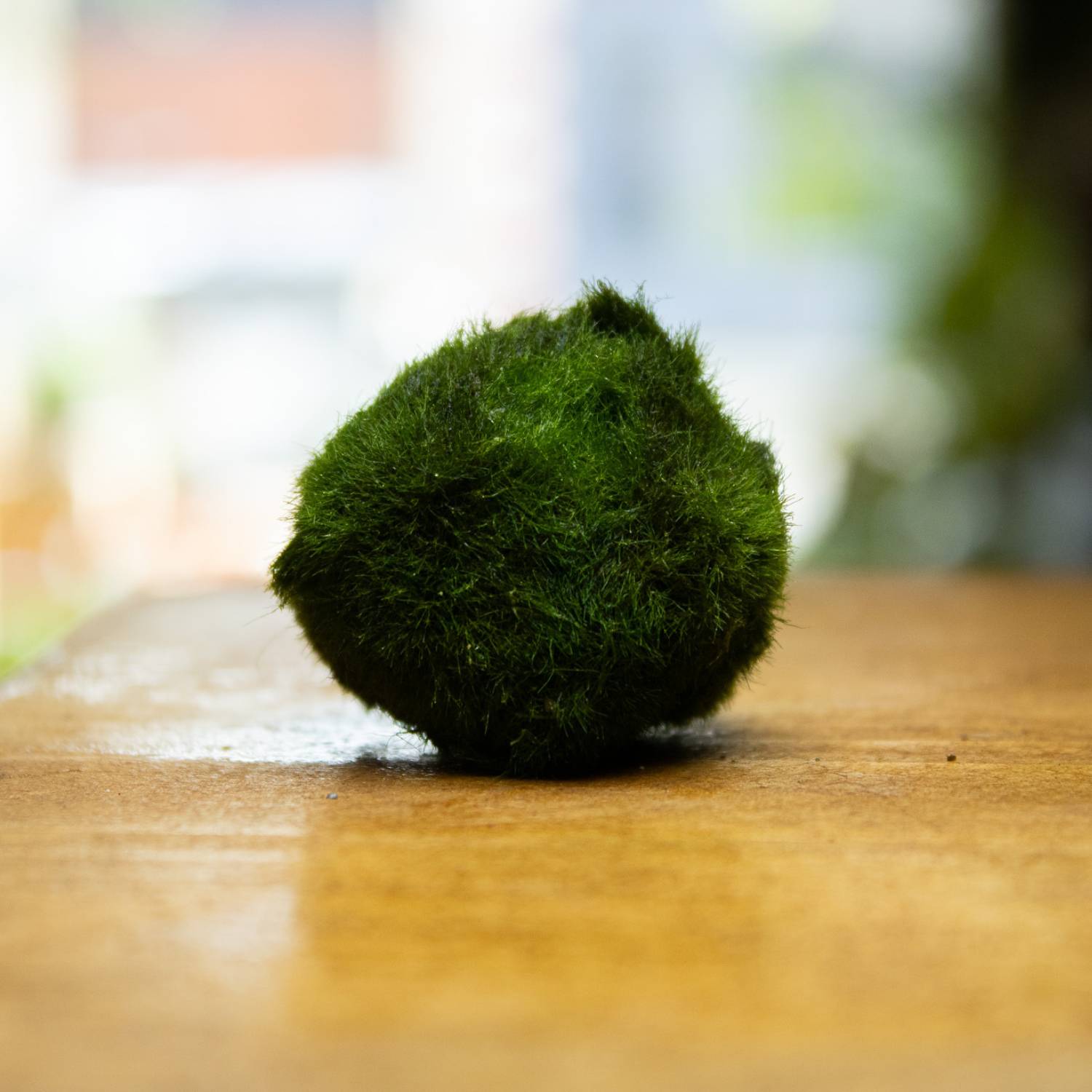
Marimo moss balls usually come as beautiful, round balls with a deep green hue.
This is your definitive guide to Marimo moss.
Together we’ll be exploring their history, their biology, how best to care for them and common problems (and how to avoid them!).
On top of that, we’ll be answering all your most frequently asked Marimo questions.
Let’s begin!
Quick Read
1 | What is Marimo Moss?
Despite their colloquial title, the moss balls we know and love aren’t actually moss at all.
They are a species of algae: Aegagropila linnaei in the genus of Cladophora.
The change of name could be a mistranslation, or perhaps a way to make the green fluffs a little more marketable.
They form via filamentous algae strings that develop a ball shape through their gentle rolling across wind-swept riverbeds.
‘Algae balls’ doesn’t have quite the same ring to it, though.
Marimo balls are native to the cold rivers and lakes of Japan, Iceland, and Northern Europe.
Though, the name ‘Marimo’ is Japanese in origin.
Botanist Tatsuhiko Kawakami termed the velvet balls in 1898. Mari meaning ‘ball’ and ‘mo’ algae.
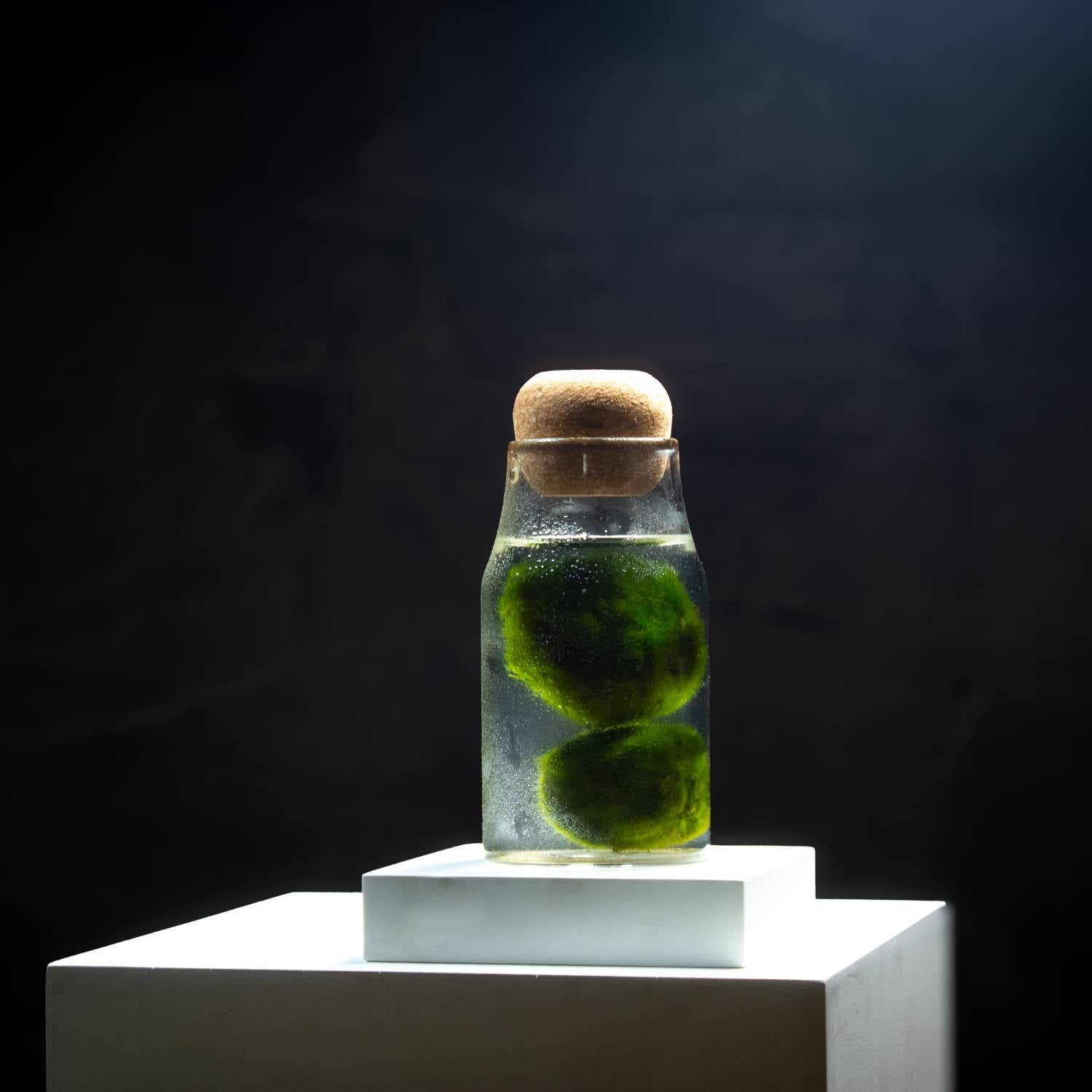
One of our ever-popular Marimo moss ball aquariums
Where can I buy Marimo Moss Balls?
We have Marimo moss balls available in our shop!
Worldwide there are strict regulations on Marimo moss balls, however.
Zebra mussels have been found on Marimo, meaning the USA has implemented a total ban on trade.
If you're USA-based and the restrictions have been lifted, it's worth having a quick look an Amazon.
Our moss balls are available only in the UK, and come from vetted supply chains.

Marimo is culturally significant to the Ainu people of Japan - symbolising love
Why Are They So Popular?
Historically, Marimo has been considered a national treasure of Japan since the early-mid 1900s.
The mythos of the Ainu people of Japan tells of two lovers, Senato and Manibe.
It is a story of forbidden love, in which the couple had to ultimately flee their disapproving tribe in hope of remaining together in eternity.
It is said the Marimo balls appeared at Lake Akan shortly thereafter, and ever since they have been regarded as a symbol of love and affection everlasting.
Marimo balls have become famed for their vivid appearance and velvety texture and have since often been referred to as ‘pets’.
I’ve even seen the term ‘marimom’ floating around.
They are notoriously easy to care for, though they do still need looking after. We’ll make sure you’ve got everything you need to get started.
The History of Marimo
Since their discovery in Japan, these rare balls became increasingly popular – eventually drawing the eyes of tourists and being sold off across the world to collectors.
They were being removed at a rate far quicker than they could replenish, and so soon became endangered within the area.
In response, Japan quickly listed the Marimo as a protected species.
This effort was championed especially by the Ainu people who have close ties with the lore of the Marimo.
However, Marimo continued to be harvested from lakes by the residents and foreigners alike.
In a bid for their restoration, people were called upon to return their balls to Lake Akan (the designated ‘home’ of Marimo) which many, fortunately, did.
These acts of kindness birthed an annual festival held at Lake Akan called ‘Marimo Matsuri’; during which the Ainu people would ritualistically return Marimo balls to the lake as a symbol of their appreciation.
Songs and dances from each of the Ainu tribes would be performed during the ceremony, it seems to be a truly joyous occasion – and one that’s been held in tradition for over 50 years.
There are a few videos of this festival you can check out on YouTube. It’s equally bizarre and beautiful to see hundreds of people ritualistically celebrating clumps of algae!

Marimo moss doesn't always come in ball-form - as here it's splayed across rock-beds.
How Does Marimo Grow?
We all know the Marimo moss ball. But, what is lesser known is the other forms Marimo can take. Naturally, it’s found in three forms:
- Densely packed algae filaments that form a ball
- As growth on shaded rocks
- Carpeted across the bottom of a riverbed, or loosely floating throughout the water
Marimo grows incredibly slowly, at a rate of up to 5 millimetres per year. In the wild, they’re known to grow up to and sometimes beyond 12 inches in diameter.
When they’ve reached their limit, Marimo moss balls can begin to reproduce asexually via a process known as ‘budding’.
If the conditions are right and you’ve got them in a roomy space, you may just be lucky enough to see a little growth on the side of one of your balls.
There's a sentence I never thought I'd write.
2 | Moss Ball Care
Marimo could well be the easiest living organism to look after. They require simple conditions and infrequent check-ups.
You do need to make sure though, that you’re giving your balls the attention they deserve (that’s the last time I make any kind of ball-based pun, I promise).
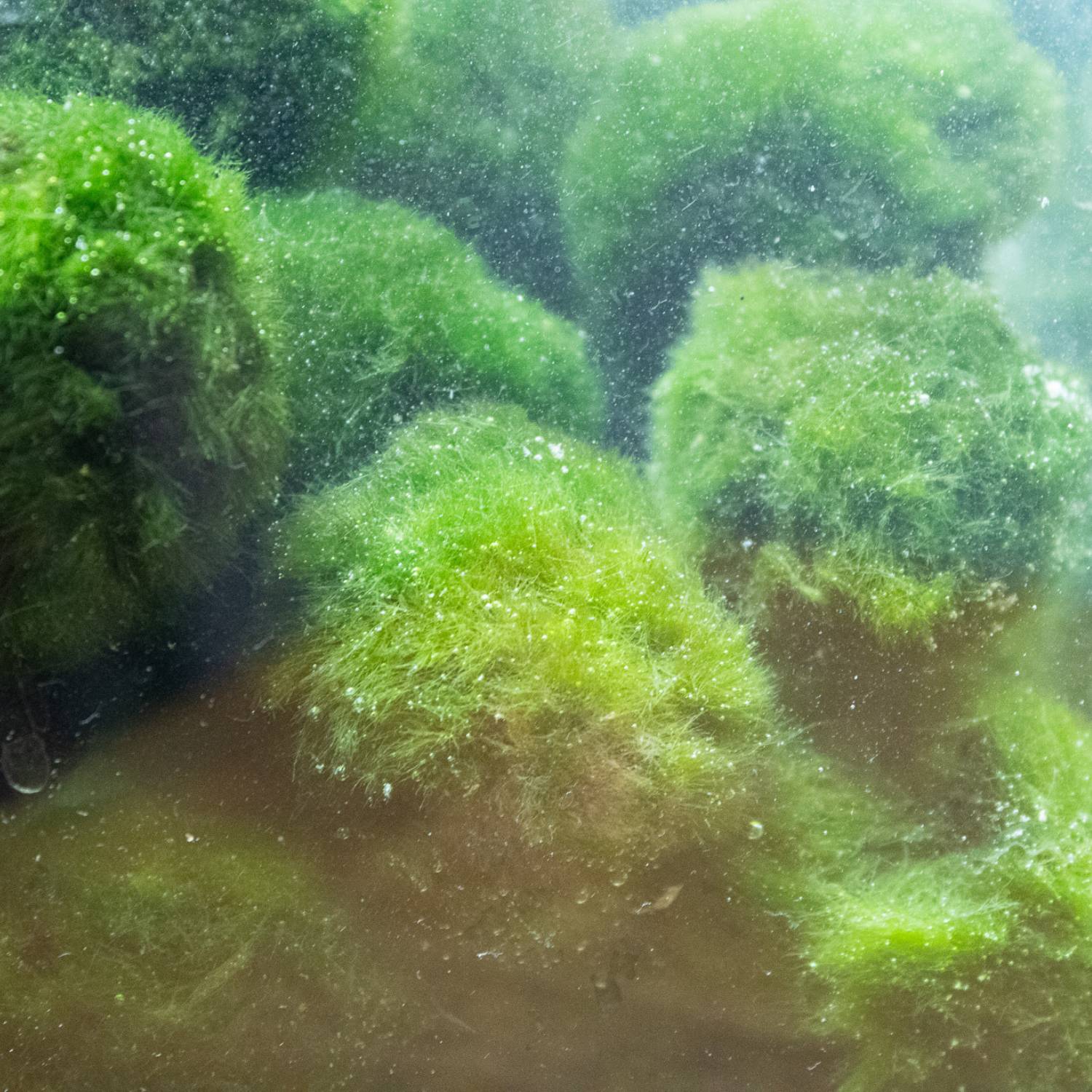
Moss balls can be kept tightly packed together, as they require very little light.
Marimo Light Requirements
Whenever you’re considering the light requirements for an organism, your first step is to look to their natural habitat.
Marimo moss balls reside predominantly at the base of rivers and lakes, therefore their preferred lighting is indirect and ambient.
Direct and/or bright light is a contributing factor to moss balls losing their colour and dying.
Light is still required for photosynthesis, so do make sure that they receive some light to grow and reproduce.
The Best Water for Marimo
Again, let’s look at their natural habitat.
Lakes and riverbeds consist of freshwater with low salt content.
Filtered or purified water is the optimal choice for your Marimo, though they are also quite happy in most tap waters, too (soft tap water, preferably).
Surprisingly, a slight saline content can be beneficial for your Marimo. It’s recommended to add a small amount of salt into your water mix to combat browning.
Brackish water is a perfectly acceptable habitat for your Marimo, but don’t let the salt content rise above 1.015.
We’ll talk a little more about this later.
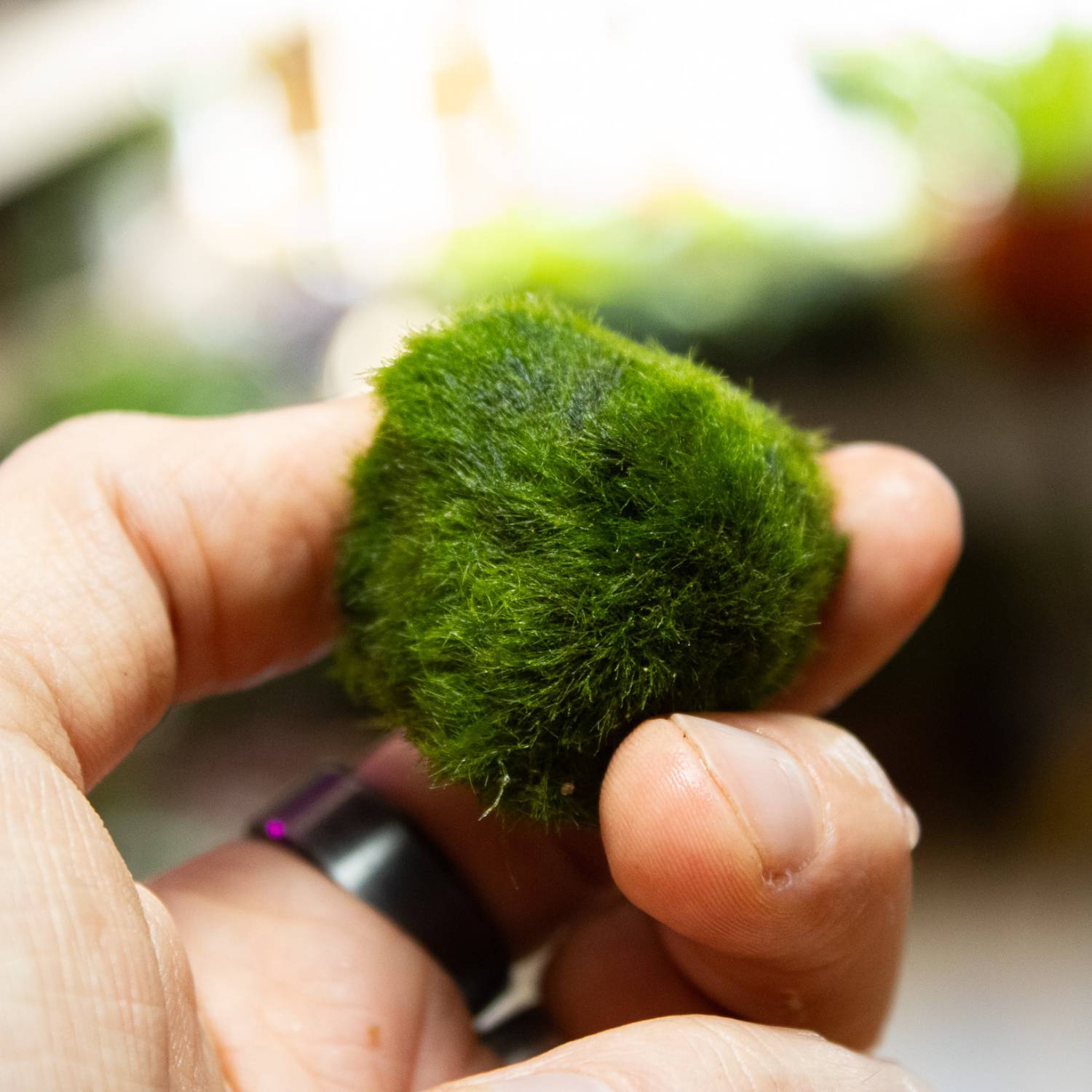
I recommend gently rolling the Marimo moss balls in your palm during water changes.
The Right Temperature for Marimo Moss
Marimo moss balls like cool waters at temperatures below 25°C (77°F) as they replicate the chilled lakebeds with which they are familiar.
Marimo balls can survive in higher temperatures, though they are unlikely to thrive in such an environment.
If you’re in a cooler part of the world (such as I am in the UK) it shouldn’t be too difficult to provide a cool living space.
Though, if you’re somewhere hotter (you lucky thing, you) you need to find somewhere that doesn’t get too much heat.
Keep your moss balls away from radiators, stoves, and electric appliances in general. And, it's best not to keep the on the windowsill.
A shady spot in a room that doesn’t receive too much sun is an optimum location.
How to Clean Marimo Moss
Changing the water
Keeping your Marimo clean is important. The wisdom varies, but generally, I recommend changing your water every two weeks.
This is considered frequent and your Marimo can sustain itself beyond this, but, I don’t like to risk it. If your Marimo is in a sealed container with no other organisms, you can get away with changing the water monthly.
When you’re changing the water, make sure to remove the Marimo balls and gently squeeze out any excess water.
Changing the water will also give your Marimo some time to rebalance its O2 / CO2 levels.
Once the water is changed, consider rotating your moss balls to ensure all sides receive light.

Look for any debris or forein algae on your Marimo during water changes.
Removing Detritus
You may notice new or existing debris on your Marimo balls. This could simply be sand, other forms of algae or mould.
You must deal with each issue correctly.
Bits of sand or other gubbins can be removed with a pair of tweezers.
Remove your Marimo from its enclosure and pinch off anything unwanted.
Then, give it a rinse in some water (the same sort of water it’s housed in) and return the Marimo to the container.
Most bits and unwanted algae (foreign algae that can suffocate your Marimo) found on your Marimo can be removed with a quick rinse and squeeze.
Repeat this process often until the unwanted algae have been removed. Make sure to only squeeze them gently. If your balls lose shape as a result – carefully roll them in your palms until they’re back to their former glory.
Move your balls to an area with less light to avoid hostile algae forming on the balls. Just remember, never use algaecides – for obvious reasons.
3 | Common Marimo Problems
My Marimo are Turning Brown / Yellow
An excess or total lack of light will turn your moss balls brown, yellow or black.
You need to make sure it’s being given a low level of ambient light. Bright light will scorch your Marimo.
You may want to consider rotating your moss balls every time you change the water to ensure browning doesn’t occur on one side.
Increasing Salinity
As well as changing the water and cleaning your Marimo, you may consider adding a small amount of sea salt to your enclosure.
This is only an appropriate step if there is nothing else in your aquarium that could take harm from sea salt.
A little salt can help browned Marimo recover, but you don’t want the salinity to rise above 1.015.
You can use a salinity meter or hydrometer to ensure your levels are correct.
A small amount of salt (a little pinch per Marimo ball) can aid growth, though too much is detrimental.

Ever-so-slightly saline water can aid in your moss ball's repair and future growth.
My Moss Balls Have Ripped
It’s not uncommon for parts of a Marimo ball to become detached or frayed over time. This is easily remedied.
Take each part of the original moss ball, gently squeeze out excess water, and gently roll them into balls in your palm.
If the Marimo has ripped but not completely detached – carefully pull the segment away from the original ball.
Don’t apply too much pressure as you will flatten the moss.
To retain its shape, mimic the light rolling Marimo naturally experiences at the bottom of riverbeds.
Why are My Marimo Balls Floating?
Marimo will typically go through periods of floating and sinking as they experience photosynthesis.
Light causes oxygen bubbles to form inside of the Marimo, which in turn carry them up to the surface of the water.
When light subsides, the oxygen depletes and the Marimo sink downwards.
It’s perfectly normal for your Marimo to go through periods of sinking and floating.
If oxygen bubbles never form and the balls never rise, it may mean that your Marimo isn’t receiving enough light.
If you don’t want your Marimo to float, you can pick them up and gently squeeze them to pop the oxygen bubble. They should now float back down.
My Moss Balls are Losing Their Shape
Marimo moss balls roll along the base of rivers and lakes to form their signature ball shape.
As I’m presuming you’ll be keeping your Marimo moss inside a container, this process won’t occur naturally.
It’s perfectly fine to take out your moss balls occasionally and gently roll them in your palm to regain their shape.
If you’re unable to capture the spherical shape you want...
Don’t panic! It doesn’t mean the moss is unhealthy.
It’s ok for things to be misshapen. The algae ball is simply behaving as it should in the environment you’ve placed it in.
Why Does My Marimo Moss Smell Bad?
Bad Marimo water can often smell like rotten eggs or sulphur. More likely than not, you need to change the water and ensure each ball is squeezed of any of the old water.
And, as with any issue you face in Marimo care, ask yourself:
-
Is the Marimo receiving too much light?
-
Is the Marimo receiving enough light?
-
Are the Marimo balls clean?
-
Am I changing the water frequently enough?
-
Is the water temperature too high?
-
Am I using the right kind of water for my Marimo?
Answering Your Questions About Marimo Moss
Where Can I Buy Marimo Moss?
You need to make sure you’re purchasing from a company you can trust that will provide authentic, responsibly sourced Marimo.
Fortunately, ome is one of those companies!
Shop Marimo Moss Balls with ome
Check out our adorable Marimo Aquariums
Due to a current restriction on international trading (curse the zebra mussel!), we are only able to supply Marimo moss and related products within the UK.
If you're USA-based and the restrictions have been lifted, it's worth having a quick look an Amazon.
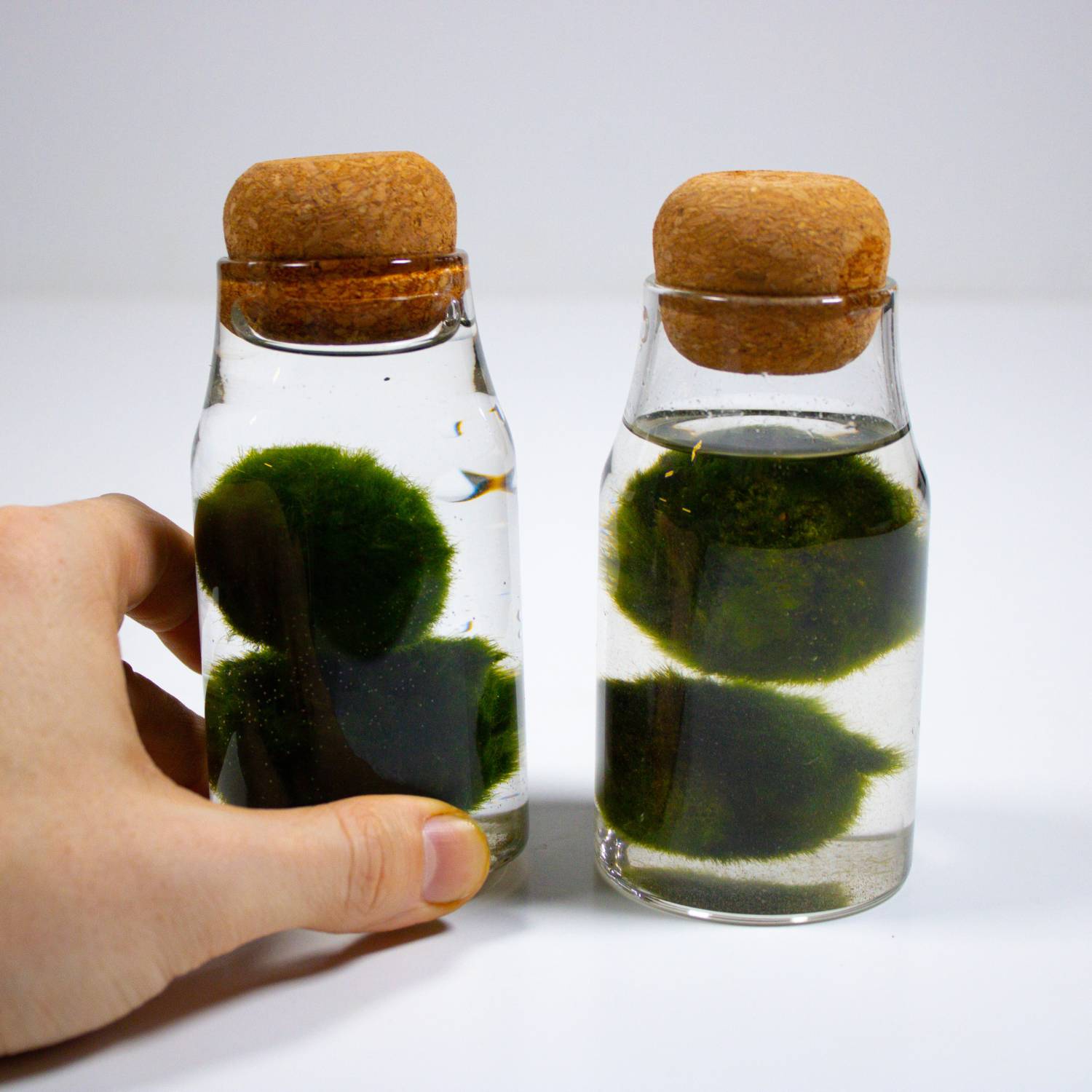
Our Marimo moss aquariums are available to deliver across the UK.
What do Moss Balls Eat?
Marimo moss balls don’t need to be fed.
They supply themselves with nutrients via the magic of photosynthesis!
To ensure this process can take place, your moss balls require light early in the day.
This can be difficult to achieve, as natural UV light is filtered through windows and blocked by roofs.
A lack of proper light can limit your moss balls’ ability to grow and photosynthesise.
You’ll know if you are successfully providing appropriate light if your moss balls rise and sink on a cyclical basis.
In their natural habitat, moss balls receive light early in the morning when the sun shines brightly.
Beyond that, they are used to complete darkness in the depths.
It is not an easy feat to either create complete darkness or replicate a properly day/night cycle for your Marimo without providing so much light that it will brown.
How to Stimulate Photosynthesis for Your Marimo
When it’s early, place your Marimo balls by a window that receives strong morning sun.
Oxygen bubbles will begin to form once they have received enough light.
Afterwards, place them somewhere dark and cool within your house to best replicate the dim, chilly conditions they are suited to.
If you’re unable to provide early morning sun you could consider using grow lights on a low power setting.
An advantage of this method is that you will generally be able to control both brightness and timing.
Yes, they do grow. Just super...super...slowly.
Do Moss Balls Grow?
They certainly do, albeit slowly.
Marimo typically grows at a rate of up to 5mm per year.
This is an incredibly slow rate of growth that is stimulated only by photosynthesis, so, read the above point if you’d like to see some long-term development in your Marimo balls!
Moss balls experience much more significant growth outside and in the wild, where their photocycle can carry itself out naturally.
An interesting point to take note of is that Marimo balls with slightly saline water will grow at a faster rate.
And, Marimo moss balls do reproduce. If the care requirements are followed strictly, you may notice a little green lump growing on the side of your Marimo!
Can Marimo Survive in a Closed Container?
Yes, they can. I know from experience.
It is best to allow your Marimo moss to breathe and get some oxygen now and again, though you’ll easily be able to achieve this with a semi-regular water change.
It’s not advisable to keep Marimo in a permanently sealed environment. Without fresh air or a change of water, they’ll likely die within months.

Marimo moss balls are a popular addition to Betta fish tanks
Can Moss Balls Go Inside My Fishtank?
Yes! Well, it depends.
Marimo is rarely a harmful disturbance for any sort of fish.
Though, many algae loving creatures such as Goldfish, Crayfish, Catfish and Shrimp will be partial to a little nibble of the green stuff.
The ever-popular Betta fish are perfect Marimo companions. They are unlikely to give your Marimo balls much notice and will leave them intact.
The less aggressive a fish is by nature, the less disturbance your Marimo is going to receive.
Rather than give you a comprehensive list we recommend that you carry out thorough research on your fish before you include Marimo in your aquarium.
Can Marimo Survive in Saltwater?
They sure can.
Marimo is known to thrive in slightly brackish water.
The largest Marimo balls have been found in areas where the ocean meets freshwater.
Though, you should bear in mind too much salt can damage your Marimo.
We recommend using a salinity meter and not allowing your levels to rise above 1.015.
Of course, if you have fish in your tank you need to prioritise their care and make sure they are tolerant to low-mid brackish conditions.
The same goes for your plants.
If each other component of your ecosystem can handle a little salt, you are absolutely fine to add some.
Try to use high-quality sea salt, as opposed to everyday table salt.
If you’ve accidentally exceeded the recommended salinity level, you can simply empty a portion of your water and replace it with fresh water, therefore diluting the mixture.
Can Marimo Survive Outside of Water?
Technically, yes.
Marimo moss balls can survive outside of water for up to one month. Though, they must not be allowed to dry out.
So, if you need to transport your Marimo you can place it inside a sealed bag with a little moisture inside to keep it alive.
We don’t recommend trying to house your Marimo outside of the water, though, it won’t last long!

Pouring one out for these little guys as we speak.
How Long can Marimo Moss Live?
Marimo moss can live for centuries!
They have been known to live for hundreds of years, and there is no real definitive answer to whether a ball has any sort of actual lifespan.
Marimo moss balls have historically been passed down as heirlooms throughout generations due to their incredible ability to survive for such a long time.
The largest reported Marimo moss ball is 37 inches in diameter, which would make it around 200 years old. That’s quite something, huh?
How big are your balls?
4 | Creative Ideas / How to Use Marimo Moss Balls
The potential uses for Marimo extend beyond simply having them in a container on display (though, this is a classically gorgeous aesthetic!)
As stated, they do not only exist in ball form. They can be manipulated, and their gorgeous texture and colour lend themselves to an array of decorative feature ideas.
Here are four creative ways you can get more from your moss ball décor.

If you use your imagination, you'll see there are tons of ways to enjoy Marimo.
1. Marimo Jewellery
If you hold Marimo close to your heart then you can, well, literally hold it close to your heart. Who doesn’t want a little terrarium necklace?
The best thing about this idea is it requires so little Marimo to do!
Now rather than discarding any flaky bits that have vacated the mother-ball, you can re-purpose them into wearable trinkets.
An alternative idea is a keychain! This is a good idea if you live in a hot, bright country where a necklace may be exposed to too much sun.
2. Decorative Trees
This is a clever way to get the most out of your Marimo.
Now, I’ve not tried this myself just yet, but I’ve seen quite a few brilliant examples out there on Pinterest and Instagram.
Unfurling your Marimo from its ball form and intertwining it with a tree-like piece of Mopani or spiderwood can create a wonderful scene within a nano aquarium.
The density and deep green colour of your moss balls lend themselves well to an underwater forest look.
3. Carpeting
When it comes to choosing a carpeting plant or moss for your aquarium, the choices are plenty.
Many carpeting plants are named as such for their ability to quickly spread across a floor.
However, this may not be exactly what you’re after. Such plants may require more frequent maintenance to keep them under control.
Enter Marimo.
Due to its slow rate of growth, Marimo is a great alternative. Not only can you now control exactly the areas you wish to carpet, but you can enjoy a rich, iridescent aquascape.
4. Floating worlds
There are ways you can creatively accentuate the shape of your Marimo.
Instead of allowing them to rest at the bed of your aquarium, use a needle to feed a thin string through them and fix them either to rocks, features, or plants.
By doing this you can have your Marimo appear to ‘float’ in the middle of the water body.
String a few together and you can create an underwater planetary look. It’s quite something when done right.
Wrapping Up
So that’s it. We’ve covered their history, care requirements, biology and even touched on some creative applications.
What’s your oldest Marimo moss ball? Do you keep fish with your Marimo, if so, what type? And finally, did we miss anything?! Let us know below.
Have a great day, everyone!
- Joe











is preconditioned beta water for bowls and aquariums appropriate for my little round dude?
Leave a comment